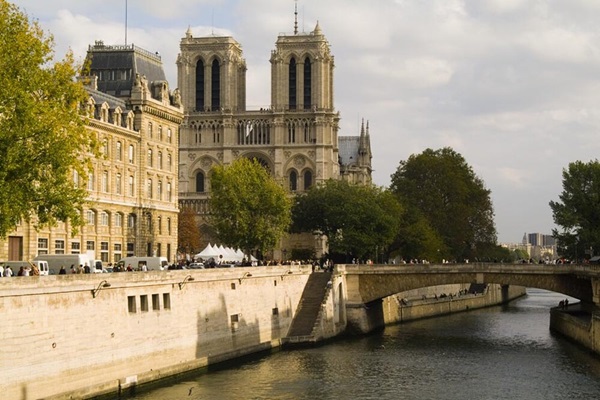 Notre Dame de Paris Cathedral, Ile de la Cité, Paris, France;
Credit: © M & G Therin-Weise
Notre Dame de Paris Cathedral, Ile de la Cité, Paris, France;
Credit: © M & G Therin-Weise
The Olympic torch relay is the ceremonial relaying of the Olympic flame from Olympia, Greece, to the site of the Olympic Games; this year it will travel through to France, Paris.
The 1936 Summer Olympic Games in Berlin introduced the torch relay by which the Olympic flame is transported from Greece. It was introduced by a German sports administrator and propagandist and was used as a form of Nazi propaganda to symbolise the spread of its influence to other countries. It also aimed to highlight the link between Nazi Germany and ancient Greece.
Despite its dark beginning, the torch relay as we know it has since become a traditional element of the modern Olympic Games, symbolising ideals of unity, friendship and peace among nations.
The first torch for the Paris 2024 Olympic Torch Relay was lit by the sun’s rays on 16 April 2024 during a ceremony in the sanctuary of Olympia, Greece, where the ancient Olympics were once held. The flame will complete its journey on 26 July in Paris, for an opening ceremony which will also take place, for the very first time in the history of the modern Olympic Games, in the heart of a UNESCO site.
The Olympic flame was then transported to Athens to board the Belem and cross the Mediterranean Sea to Marseille. On 8 May 2024, the Olympic flame embarked on its journey across France. The flame will travel to the Lascaux caves, the Alésia archaeological site, the medieval city of Carcassonne, the Palace of Versailles, and many other sites. It will light up many of France's architectural masterpieces, beginning with the world-renowned site of Mont Saint-Michel. Other highlights will include the Châteaux of the Loire Valley, along with a plethora of iconic palaces, lighthouses, bridges, viaducts, and arenas. To honour the history of France, the flame will also visit places of remembrance, such as the Verdun Memorial and the D-Day Landing Beaches.
The Olympic Torch Relay will be an opportunity to pay tribute to the memory of the people who have left a mark on France’s history. Along its route, the Olympic Torch Relay will highlight notable French personalities who continue to inspire and contribute to our country’s influence and reputation: Joan of Arc in Orléans, Robert Schuman in Scy-Chazelles and Charles de Gaulle in Colombey-les-Deux-Eglises.
French culture in all its forms will be celebrated during the 68 days of the Olympic Torch Relay. The flame will visit several museums, from the Cité Internationale de la Langue Française to the comic art museum and the Louvre-Lens. Culture also means live shows: the flame will pass by the Puy du Fou, visit the Arles Amphitheatre, and climb up the steps of the Palais des Festivals in Cannes.
In approximately two and a half months, the flame will visit 64 territories, creating connections with people across all regions of France.
The departments were involved in selecting the visited cities and each proposed about ten cultural, natural or sports sites of significant importance to their region.
Based on this, Paris 2024 has constructed the final route of the Olympic Torch Relay. The full route will reach the following UNESCO sites:
- 12 May – Arles, Roman and Romanesque Monuments;
- 16 May – Historic Fortified City of Carcassonne;
- 18 May – Cathédrale Sainte-Marie d'Auch, part of the Routes of Santiago de Compostela in France;
- 19 May – Cirque de Gavarnie, forming part of the Pyrénées, Mont Perdu;
- 22 May – Cathédrale Saint-Front de Périgueux, part of the Routes of Santiago de Compostela in France;
- 23 May – Bordeaux and nearby (Juridiction de Saint-Emilion, Bordeaux, Port de la Lune);
- 31 May – Mont-Saint-Michel and its Bay;
- 12 June – Piton de la Fournaise, Pitons, cirques and remparts of Reunion Island;
- 17 June - Volcanoes and Forests of Mount Pelée and the Pitons of Northern Martinique;
- 18 June - Nice, Winter Resort Town of the Riviera;
- 19 June - Roman Theatre and its surroundings and the "Triumphal Arch" of Orange;
- 21 June – Vichy, one of the Great Spa Towns of Europe;
- 25 June - Citadelle de Besançon, forms part of the Fortifications of Vauban;
- 26 June - Strasbourg, Grande-Île and Neustadt;
- 30 June - Cathedral of Notre-Dame, Former Abbey of Saint-Rémi and Palace of Tau, Reims;
- 30 June - Champagne Hillsides, Houses and Cellars;
- 2 July - Belfries of Belgium and France;
- 3 July - Nord-Pas de Calais Mining Basin;
- 4 July - Amiens Cathedral;
- 5 July - Le Havre, the city rebuilt by Auguste Perret;
- 7 July - Chartres Cathedral;
- 8 & 10 July - The Loire Valley between Sully-sur-Loire and Chalonnes;
- 11 July - Vézelay, Church and Hill;
- 12 July - The Climats, terroirs of Burgundy;
- 20 July - Palace and Park of Fontainebleau;
- 20 July - Provins, Town of Medieval Fairs;
- 23 July - Palace and Park of Versailles;
- 26 July - Paris, Banks of the Seine.








